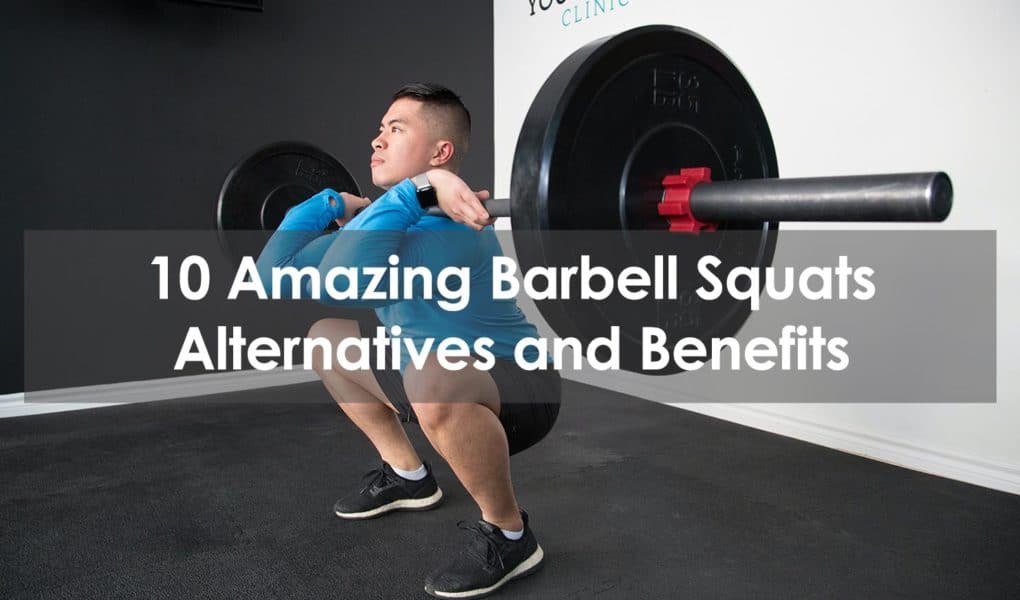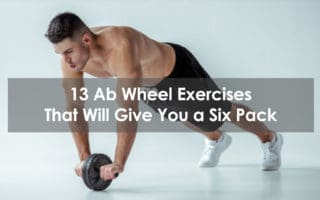The barbell squat is synonymous with strength. It is one of a few movements which can instantly give you an accurate portrayal of a person’s full body strength levels. This is why it is a cornerstone in just about every single true strength-building program.
Training the barbell back is the number one lower body exercise due to the increased range of motion and flexion involved in the joints. Being so, it is a great movement to grow your quadriceps, hamstrings, and glutes and build leg strength. Still, you’re going to get a great core and upper back activation with isometric holds to create a strong base.
Benefits of Having Barbell Squat Alternatives
Even though the barbell squat is an amazing exercise, there are a couple of reasons why you want some great alternatives in your arsenal. Having an alternative exercise to perform instead of the barbell squat is going to make you a better lifter. Using these movements is going to make you a better all-around lifter and increase your absolute strength, functional strength, and muscle growth. Here are some of the primary reasons you should have some alternatives.
1. Injuries or mobility may prevent you from performing the back squat.
Being that the barbell squat does use the entire body, there are a lot of areas that may prevent you from being able to do them properly. Lower back, knees, hips; all of these are common areas of the back squat which may affect your ability to perform them.
2. Adds a variety of stimuli.
Using just one exercise to train a body part is rarely ever done. Can you imagine only performing the bench press for the chest? By using different exercises, you can apply a load in a slightly different manner for maximum muscle activation. This is a common way to maximize strength and hypertrophy.
3. Prevents Plateaus.
In conjunction with #2, having other effective alternatives can be used to swap out exercises when thing’s beginning to come stale. This can not only keep things interesting but is also a great way from remaining in a slump. When progression stales with the barbell squat, replace it with one of these alternatives and improve on that, then go back to the barbell squat.
10 Great Barbell Squat Alternatives
1. Barbell Front Squat
Alternate setup with a cross-arm front squat:
The obvious squat variation to the barbell “back” squat is the barbell “front” squat. This movement is highly underutilized but extremely effective and a favorite of top conditioning coaches. There is even a good argument that it could even be a better movement than the back squat, especially for athletes.
With the front bar back squat, the bar goes in front of the body by creating a shelf with your shoulders in a position known as the rack position. This causes the body to have a more upright position going down with greater knee flexion. Since you are upright, there will be fewer compressive forces on your lower back. Expect to really feel this in your quads and build massive core strength.
Be aware that the front squat requires a high degree of mobility including upper-body mobility.
Equipment Needed
- Barbell
- Squat Rack
- Weight Plates
How to Perform
- Setup a rack in the same manner as a back squat EXCEPT you will likely want the bar slightly lower around chest height. The foot position will be more straight than a regular back squat.
- Stand up the bar so that you can place it on your upper chest
- Create a “rack” with your arms by bringing your elbows up and placing your fingers on the bar
- You do not fully grasp the bar. Just a few fingers will do. They. are mainly there to maintain balance
- Make sure to keep your elbows high the entire movement
- Unrack the bar and set the feet in a slightly narrower position then your squat
- Come down by bending at your knees and maintaining a vertical torso
- Once you hit bottom, come back up.
2. Safety Bar Squat
The safety bar squat is extremely common in the strength world. It is a great exercise to perform as the movement is very similar to a regular squat but tends to be much more comfortable.
The only thing is you need a specialty bar; a safety squat bar. A safety squat bar looks dramatically different than a standard bar as there are two handles that come out near your neck. This creates a U shape which is covered in pads. This is where the bar sits on the body.
Being that there are two handles you can hold onto, there is no stress on your shoulders or wrists which makes it perfect for those with discrepancies in mobility; or for anyone who wants an alternative!
Equipment Needed
- Safety Squat Bar
- Squat Rack
- Weight Plates
How to Perform
- Set up the rack with the safety bar
- Get under the bar so that your head is between the handles.
- Take some time to situate the bar in a comfortable spot
- Grab the handles and unrack the bar
- Step back in a normal squat position and perform as normal
3. Belt Squat
Belt squats are amazing! These are perhaps the best squat alternative for those who have lower back issues. Instead of using a barbell to apply a load, a belt squat uses a belt that is connected to a pulley system. This results in the trainee being able to do an identical movement to the squat but with zero pressure on the back making it at the top choice for safety reasons.
Obviously, this takes out the core activation, but you should be able to use heavy loads with total comfort.
Equipment Needed
There are two options:
- A proper belt squat machine
- A regular dip belt and boxes
How to Perform
Using Squat Belt Machine
- Load the machine first
- Step inside the belt and situate it to sit on your hips
- Stand tall to lift the weight and unrack
- Perform a squat in your desired stance
Using A Squat Belt And Boxes
- Set up the boxes so they are at least 3-4 inches off the ground. This will depend on your belt length. The boxes need to be high enough so they will not touch the ground
- Add plates and attach the belt
- If possible, do this while already standing on the boxes
- Stand over the gap between the boxes and perform squats
4. Zercher Squats
Zercher squats are a long-lost favorite of ol’ time lifters. That being said, it could just be the new stimulus you need for full-body development.
It uses all of the same equipment as a barbell squat except that instead of supporting the bar of high, you cradle it in your arms using the nook of your elbows. This creates an insane upper body and core stimulus.
It can be uncomfortable, especially when you first start, so you may want to use some sort of guard. Many consider the Zercher squat to be the ultimate “squat fixer” as there is no room for poor form. This makes it a good corrective exercise as it will highlight any underlying issues that are preventing clean form.
Equipment Needed
- Barbell
- Squat Rack
- Weight Plates
How to Perform
- Rack a bar in a much lower position than normal. It should be slightly lower than the height of your elbow.
- Place knee or elbow sleeves over your arms if desired
- Walk up to the bar and place it in the nook of your elbows. Wrap your arms around. Many people will cross their arms
- Step back and perform your squat
- Be sure to maintain back stability
- Start with low weights. You’d probably benefit from just using a bar to start
5. Trap Bar Deadlift
Many are surprised when the trap bar deadlift is suggested but when looking at the biomechanics, you’ll see that the trap bar deadlift is quite common to the squat in terms of knee flexion and hip flexion. This means you will actually get higher muscle activity in the quadriceps.
Plus, you are able to use a relatively heavyweight when performing trap bar deadlifts. Keep in mind this does not apply to other variations such as the regular barbell deadlift or stiff-leg deadlifts.
The other benefit is that there is significantly less torque on the back due to a more upright position making it ideal for those with nagging back issues. Plus, many trainees with knee pain report less discomfort when performing the trap bar deadlift most likely as the knee flexion is a bit less.
Equipment Needed
- Trap Bar
- Rack
- Weight Plates
How to Perform
- Place weight onto the trap bar
- Step into the middles of the trap bar so your feet are in line with the handles
- Bend down to grab the handles
- Bend your knees and push your hips back to get into a deadlift-like position
- To perform the movement more similar to a back squat, let your knees come forward some rather than keeping them vertical like in a deadlift. This will put more stress on the quads
- Stand up with the weight
6. Landmine Squats
Landmine squats are a favorite as they’re easy to set up and a hybrid of machines and free weights. In this instance, you are still using your full body for the movement as well as your stabilizing muscles to mitigate movement. It’s a great exercise and can easily be used by any level of athlete. Landmine squats benefits include; ease of set-up, ease to learn, and very effective exercise.
Tip: Using landmine exercises is a great way to train the whole body quickly.
Equipment Needed
- Barbell
- Landmine Attachment
- Weight Plates
How to Perform
- Setup your landmine
- In one motion, lift the bar up so that the end is in your chest
- Grab the end of the barbell with both hands interlocked. The bar should sit in a “cup” made by your hand
- In the starting position, keep the barbell up against your chest
- Stand back up
- Be sure to keep the barbell close to the body during the entire movement.
7. Leg Press
One of the best machines and used by almost everybody; even the most strict, anti-machine trainer. The leg press is great for various reasons.
First, it decreases compressive forces on the back so this is great for those with lower back issues and decreases the chance of injury.
Secondly, there are a ton of variations that you can do with this one machine. You can use a narrower stance, angle your feet, or even use it for unilateral exercise presses (1 leg).
Thirdly, it can be used for those who just aren’t athletic enough to perform real squats.
As mentioned, squats do require an amount of skill and athleticism to perform and some clients just aren’t able to. The leg press is a great movement to use to place a heavier absolute load on the client with minimal risk of injury. One common practice is to use lightweight while the basic form of the barbell squat in conjunction with a heavy leg press for stimulus.
Equipment Needed
- Leg Press
- Weight Plates (If plate loaded)
How to Perform
- Set up the leg press machine
- Place your feet slightly wider than hip-width apart
- Angle your feet out slightly
- Push up and unrack the load
- Allow the weight to come down by tucking your knees back
- Your knees should go slightly outside of your body
- Push the load up
8. Pulse Body Squats
Pulse body squats are one of the best back squat alternatives for a home workout and better than just a normal bodyweight air squat. A body squat obviously doesn’t use a load by definition.
To increase the intensity, a pulsing body squat will have a trainee do a full eccentric motion, come up to about a 3/4 squat, then back down. This motion can be repeated any amount of times but 3-4 is the norm. What occurs is your muscle fibers are under tension for an extended amount of time for higher muscle activity.
Equipment Needed
- Bodyweight only!
How To Perform
- Place your feet slightly wider than hip-width apart
- Come down by pushing your hips back and allowing your knees to come forward slightly
- Once you hit slightly below parallel, come back up to about 3/4 of the way.
- Without pausing, go back down.
- Repeat this motion for a prescribed amount of time.
9. Split Squat
Split squats are a fantastic exercise for building leg strength. Unlike bilateral exercises, split squats are a form of unilateral training meaning it concentrates on one leg.
Split squats look similar to lunges except the feet don’t move during the pattern. Some athletes are unable to maintain natural and consistent lunge patterns when they perform the exercise making split squats a bit simpler in terms of ease. Further, you are able to perform dumbbell split squats, barbells split squats; or any other variety.
Equipment Needed
- Barbell or Dumbbell
- Squat Rack (if using a heavy barbell)
- Weight Plates (If using a barbell)
How To Perform
- Place one leg in front of the other
- Perform some reps unloaded to make sure you have the correct form
- If your feet are spaced correctly, when you go straight down, both your knees should have a 90-degree angle while. This means your front shin should be vertical and your back thigh should be vertical (this may angle some when you push up). These are great to train the quad muscles
- Either unrack a barbell or pick up dumbbells
- Go straight down. Do not push forward which is a common mistake
- Push yourself up
10. Goblet Squat
Goblet squats are a great exercise to perform which is similar to the front squat and Zercher squat but a bit simpler to perform. The movement is performed by holding a dumbbell or kettlebell at chest level with the hands making a big U shape. This is how it gets the name “goblet” squat as your hands look like a goblet (very large cup).
The squat is performed in this position. It will work the core muscles along with being a great leg exercise. It is usually performed later in a session with high reps or as a finisher
Equipment Needed
- Dumbbell or Kettlebell
How To Perform
- If using a kettlebell, flip it upside down
- Hold a kettlebell or dumbbell in your hands shaped like a U
- Be sure to keep your arms close to your body with your elbows under the implement
- Come down into a squat pattern (it will be more similar to a front squat)
- Come back up
- Keep your back and core tight. Don’t lean over
Reps To Use
These exercises can be used with loads across the entire spectrum. Stick to using heavier weights with fewer reps if you’re more interested in strength gains and lighter weights with higher reps for muscle hypertrophy.
Time To Squat!!!
Traditional squats are amazing but with these squat variations, you’ll make some massive strength gains in the lower body. No matter your fitness goal, barbell squatting is going to help you get there. Even if you don’t have any of the common issues that prevent you from performing the back squat, use these alternatives in addition regardless of your primary goal.
Frequently Asked Questions
Are squats bad for knees?
They can be if done improperly. Squats are a natural, functional exercise making them great for building strength and improving mobility. However, you need to spend time learning proper form before you move on to performing heavy squats. Knee pain generally comes from improper knee travel so be sure to keep the knees over your toes and slowly build strength.
What can I use if I don’t have a barbell?
You can use almost anything that adds a load. A common practice is to use something like a 50-lb weighted vest, dumbbells, kettlebells, sandbags, you may even see some lifters use some sort of pole they found for “junkyard” workouts. Just be mindful that tall of these will alter your form a bit.







